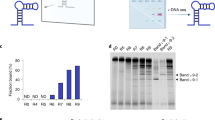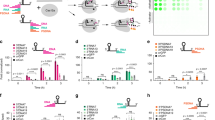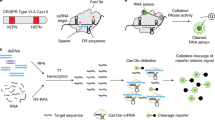Abstract
We have selected an allosteric ribozyme ligase from a random sequence population that is activated up to 10,000-fold by oligonucleotide effectors. The ribozyme conforms to a classic two-state model for allostery in which the equilibrium between inactive and active conformers is dramatically altered by the presence of effector ligands. In the presence of the effector the allosteric ribozyme ligase generates templates that can subsequently be amplified using conventional amplification technologies, such as RT-PCR. Thus, the allosteric ribozyme can transduce (or convert) analytes into amplicons. We demonstrate two potential diagnostic applications of the selected allosteric ribozyme ligase: 'counting' short oligonucleotide effectors by RT-PCR, and counting a non-nucleic acid effector, ATP, by ligation.
This is a preview of subscription content, access via your institution
Access options
Subscribe to this journal
Receive 12 print issues and online access
$209.00 per year
only $17.42 per issue
Buy this article
- Purchase on Springer Link
- Instant access to full article PDF
Prices may be subject to local taxes which are calculated during checkout





Similar content being viewed by others
References
Porta, H. and Lizardi, P.M. 1995. An allosteric hammerhead ribozyme. Bio/Technology 13: 161–164.
Tang, J. and Breaker, R.R. 1997. Rational design of allosteric ribozymes. Chem. Biol. 4: 453–459.
Tang, J. and Breaker, R.R. 1997. Examination of the catalytic fitness of the hammerhead ribozyme by in vitro selection. RNA 3: 914–925.
Tang, J. and Breaker, R.R. 1998. Mechanism for allosteric inhibition of an ATP–sensitive ribozyme. Nucleic Acids Res. 26: 4214–4221.
Araki, M., Okuno, Y., Hara, Y., and Sugiura, Y. 1998 . Allosteric regulation of a ribozyme activity through ligand–induced conformational change. Nucleic Acids Res. 26: 3379–3384.
Jaeger, L. 1997. The new world of ribozymes. Curr. Opin. Struct. Biol. 7: 324–335.
Breaker, R.R. 1997. In vitro selection of catalytic polynucleotides. Chem. Rev. 97: 371–390.
Pan, T. 1997. Novel and variant ribozymes obtained through in vitro selection. Curr. Opin. Chem. Biol. 1: 17– 25 .
Tanner, M.A., Anderson, E.M., Gutell, R.R., and Cech, T.R. 1997. Mutagenesis and comparative sequence analysis of a base triple joining the two domains of group I ribozymes. RNA 3: 1037–1051 .
Wang, J.F., Downs, W.D., and Cech, T.R. 1993. Movement of the guide sequence during RNA catalysis by a group I ribozyme. Science 260: 504–508.
Herschlag, D. and Khosla, M. 1994. Comparison of pH dependencies of the Tetrahymena ribozyme reactions with RNA 2´–substituted and phosphorothioate substrates reveals a rate–limiting conformational step. Biochemistry 33: 5291– 5297.
Costa, M., Deme, E., Jacquier, A., and Michel, F. 1997. Multiple tertiary interactions involving domain II of group II self–splicing introns. J. Mol. Biol. 267: 520– 536.
Bartel, D.P. and Szostak, J.W. 1993. Isolation of new ribozymes from a large pool of random sequences. Science 261: 1411–1418 .
Hager, A.J. and Szostak, J.W. 1997. Isolation of novel ribozymes that ligate AMP–activated RNA substrates. Chem. Biol. 4: 607–617.
Cuenoud, B. and Szostak, J.W. 1995. A DNA metalloenzyme with DNA ligase activity. Nature 375: 611–614.
Ekland, E.H., Szostak, J.W., and Bartel, D.P. 1995. Structurally complex and highly active RNA ligases derived from random RNA sequences. Science 269: 364–370 .
Creighton, T.E. 1993. Proteins: structures and molecular properties , W.H. Freeman and Co., New York.
Scott, J.D., Fischer, E.H., Demaille, J.G., and Krebs, E.G. 1985. Identification of an inhibitory region of the heat–stable protein inhibitor of the cAMP–dependent protein kinase. Proc. Natl. Acad. Sci. USA 82: 4379– 4383.
House, C. and Kemp, B.E. 1987. Protein kinase C contains a pseudosubstrate prototope in its regulatory domain. Science 238: 1726–1728.
Poteet–Smith, C.E., Shabb, J.B., Francis, S.H., and Corbin, J.D. 1997. Identification of critical determinants for autoinhibition in the pseudosubstrate region of type Iα cAMP–dependent protein kinase. J. Biol. Chem. 272: 379– 388.
Guatelli, J.C., Whitfield, K.M., Kwoh, D.Y., Barringer, K.J., Richman, D.D., and Gingeras, T.R. 1990. Isothermal, in vitro amplification of nucleic acids by a multienzyme reaction modeled after retroviral replication. Proc. Natl. Acad. Sci. USA 87: 1874– 1878.
Sassanfar, M. and Szostak, J.W. 1993. An RNA motif that binds ATP. Nature 364: 550 –553.
Acknowledgements
This work was supported by a grant from Intelligene.
Author information
Authors and Affiliations
Corresponding author
Rights and permissions
About this article
Cite this article
Robertson, M., Ellington, A. In vitro selection of an allosteric ribozyme that transduces analytes to amplicons. Nat Biotechnol 17, 62–66 (1999). https://doi.org/10.1038/5236
Received:
Accepted:
Issue Date:
DOI: https://doi.org/10.1038/5236
This article is cited by
-
An RNA-cleaving threose nucleic acid enzyme capable of single point mutation discrimination
Nature Chemistry (2022)
-
Aptazyme-embedded guide RNAs enable ligand-responsive genome editing and transcriptional activation
Nature Communications (2017)



